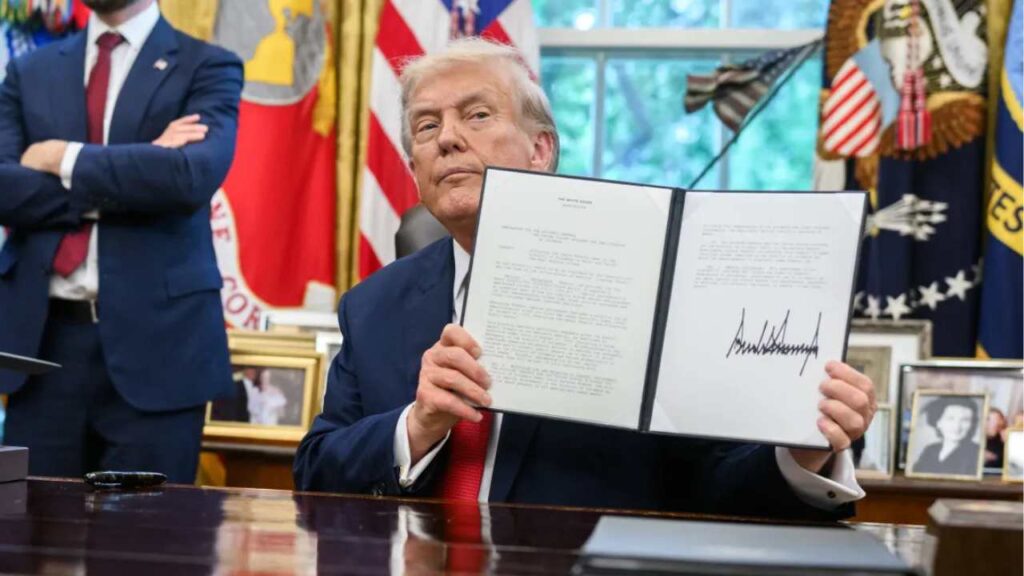The administration of President Donald J. Trump has set a legislative precedent with the passage of the One Big Beautiful Bill Act (OBBBA), colloquially referred to as the “Big Beautiful Bill” that includes, among other legislations and regulations, stimulus checks for those how want to be parents.
This comprehensive legislation, signed on July 4, 2025, on the South Lawn of the White House, aims primarily to stimulate the United States economy through tax reform, work incentives, and, innovatively, a savings mechanism for newborns. It’s similar to a stimulus check that can grow into thousands of dollars over time.
The “Trump Accounts” stimulus checks: how do they work?
In fact, it can grow to over $93,000 if left untouched and the magic of compound interest is allowed to work on these funds. But how do you access this benefit and turn it into such a juicy sum?
Among the most significant provisions of the OBBBA are the “Trump Accounts,” an instrument designed to provide each newborn with a seed fund provided by the federal government, with the goal of promoting long-term savings and family strength.
This measure is a direct response to Trump’s pro-birth agenda and has achieved an unusual political consensus, backed by BlackRock polls indicating 66% support. The implementation of the OBBBA occurs in a complex demographic scenario, where the birth rate has fallen below 1.6 children per woman and the average household debt exceeds $100,000.
Free $1,000 for each child born through 2028
The legislation, inspired by 2024 campaign proposals that included a $5,000 birth bonus, sets an initial amount of $1,000, but expands its usefulness through tax breaks and the possibility of additional contributions.
President Trump defended his OBBBA as a central plank of his “America First 2.0” platform, arguing that encouraging births and savings is an antidote to the “family crisis,” exacerbated by post-pandemic inflation and labor migration.
This is how the Trump Accounts stimulus checks work
Trump Accounts are created as tax-advantaged savings accounts, analogous to a 529 plan or a Roth IRA for children, and are managed by financial institutions authorized by the IRS.
Every U.S. citizen child born between January 1, 2025, and December 31, 2028, receives an initial $1,000 deposit from the federal government, which is credited directly to the account at birth. This seed money is automatically invested in moderate-risk index funds, and its growth is tax-free as long as it is used for qualified purposes.
Parents can add up to $5,000 per year
Regarding its operation, parents, legal guardians, or relatives have the right to make additional contributions of up to $5,000 annually, of which $3,000 are tax-deductible each year. These funds can accumulate until the beneficiary turns 18.
The funds mature with annual compounding and can be withdrawn penalty-free to fund higher education, the purchase of a first home, or retirement after age 59.5. Early withdrawals for non-qualified purposes carry a 10% penalty, similar to that of a traditional IRA.
The program is established as a pilot for a four-year period, with the possibility of extension subject to an evaluation of its participation rates and effectiveness.
Who is eligible for the stimulus payment
In terms of eligibility, the program applies to all children born in the United States during the established period, regardless of their parents’ immigration status, a significant inclusion benefit for immigrant families.
Children born before 2025 can open accounts retroactively, although they will not have access to the initial $1,000 bonus, while retaining all other tax benefits.
To access the benefit, parents must register the birth with the Social Security Administration and notify the IRS through a digital portal or mobile app, with automatic deposits being made within 30 to 60 days.
$1,000 stimulus checks that can be multiplied 90 times
Trump Accounts have the potential to disrupt intergenerational economic mobility. A Brookings Institution analysis projects that, with average family contributions of $2,000 annually, a child could accumulate more than $100,000 by age 18, enough to cover college tuition or a down payment on a home.
Regarding the growth of the initial $1,000 bonus if it remains unwithdrawn until Full Retirement Age (FRA, set at 67 for those born after 1960), the effect of compound interest becomes decisive. For a child born in 2025, this implies an investment horizon of 67 years.
Considering different compound annual rates of return and excluding additional contributions, the projections are as follows:
At a conservative rate of 4%, comparable to long-term Treasury bonds, the initial fund would turn into $13,843. At a moderate rate of 5%, reflecting the historical average for mixed portfolios, the final value would be $26,283.
Furthermore, at a more aggressive rate of 7%, aligned with real stock market returns adjusted for inflation, the investment could reach $93,049.
